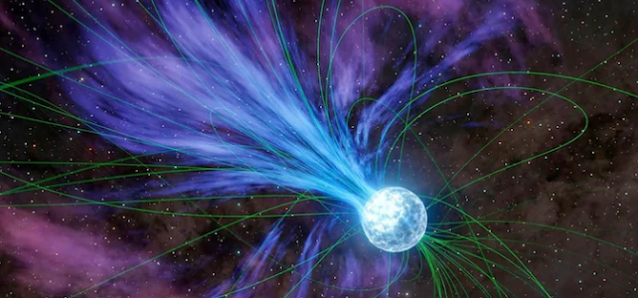 |
| Explosive Evidence: Distant Magnetar Flare in M82 Galaxy |
Magnetars: Nature's Powerhouses
- Origin: Neutron stars, the collapsed cores of massive stars, can become magnetars if they possess exceptionally strong magnetic fields.
- Strength: These magnetic fields are the most powerful ever detected in the universe, exceeding anything else by a significant margin.
- Flares: Occasionally, magnetars release tremendous bursts of gamma rays called giant flares. These rank as the most powerful non-destructive energy releases known in the cosmos.
A Rare Detection Beyond Our Galaxy
- Previous Events: Up until recently, only three confirmed giant flares were observed – two in our Milky Way (1998 & 2004) and one in the Large Magellanic Cloud (1979).
- New Discovery: In November 2023, ESA's Integral space observatory detected a giant flare originating from the M82 galaxy (Cigar Galaxy), a staggering 12 million light-years away.
- Confirmation: Follow-up observations with XMM-Newton telescope distinguished this event from short gamma-ray bursts (caused by neutron star mergers) and further supported the magnetar giant flare hypothesis.
Significance of the M82 Flare
- Record Breaker: This detection marks the farthest observed giant flare to date.
- Starburst Connection: The location within M82, a starburst galaxy with a high rate of star formation, is crucial. It strengthens the theory that massive stars in such environments live a short, intense existence, leaving behind young, active magnetars with rapid spin and powerful magnetic fields.
Future Exploration
- More Magnetars: This discovery paves the way for finding more extragalactic magnetars, especially in starburst galaxies.
- Unveiling Mysteries: Studying these distant flares can help us understand:
- Frequency: How often do giant flares occur?
- Energy Loss: How do magnetars lose energy during these events?
- Neutron Star Evolution: How do these stars evolve over time?
- Massive Star Insights: This research will also provide valuable insights into the life cycles of massive stars, particularly in environments with intense star formation.
Overall, the M82 giant flare discovery is a major breakthrough in our understanding of these extreme cosmic objects and their role in the grand story of stellar and galactic evolution.
